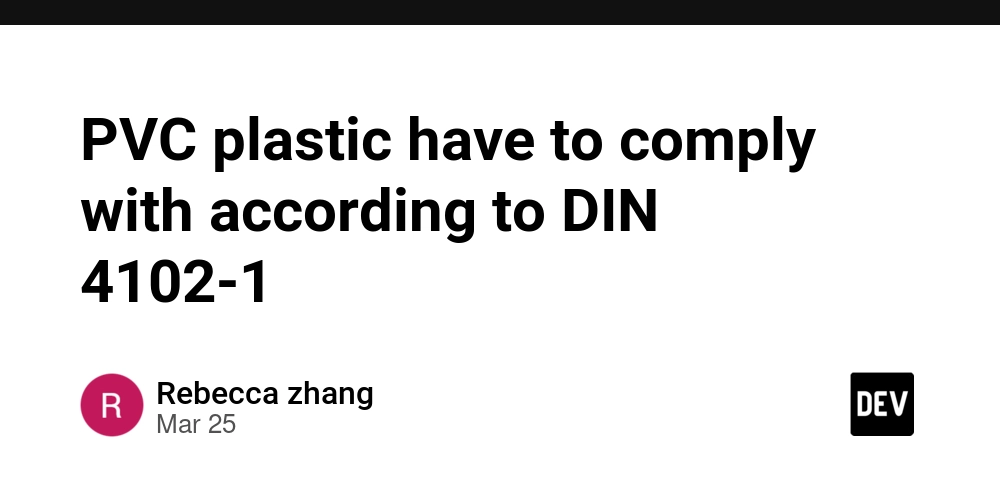PVC plastic have to comply with according to DIN 4102-1
Regarding the grade of PVC plastic in fire test, generally: PVC (polyvinyl chloride) plastic usually belongs to B1 or B2 grade. B1 grade (flammable material): Material properties meet some conditions: PVC plastic may reach B1 grade after special flame retardant treatment. B1 grade materials have flame retardant properties under certain conditions, slow burning speed and small flame propagation range. Adding suitable flame retardants and other chemicals to PVC can improve its combustion performance, so that it has better flame retardancy under specified test conditions. For example, in some PVC wire sheath products used in construction, flame retardants are added to slow down the burning speed and prevent the rapid spread of flames when encountering small fire sources. B2 grade (combustible material): Untreated or improperly treated conditions: If PVC plastic has not been effectively flame retardant or the amount of flame retardant added is insufficient, it will usually be judged as B2 grade. B2 grade materials are easy to burn under specified test conditions, with a faster burning speed and a larger flame propagation range. Ordinary PVC films or some low-quality PVC products may show strong flammability and fast flame propagation in fire tests. It should be noted that the specific fire rating of PVC plastics is also affected by its formula (such as the type and proportion of plasticizers, fillers and other ingredients), the shape and thickness of the product and other factors. In practical applications, for PVC products used in areas with high fire protection requirements such as construction, fire tests should be strictly carried out in accordance with DIN 4102-1 standards to determine their accurate fire rating.

Regarding the grade of PVC plastic in fire test, generally: PVC (polyvinyl chloride) plastic usually belongs to B1 or B2 grade.
B1 grade (flammable material):
Material properties meet some conditions: PVC plastic may reach B1 grade after special flame retardant treatment. B1 grade materials have flame retardant properties under certain conditions, slow burning speed and small flame propagation range. Adding suitable flame retardants and other chemicals to PVC can improve its combustion performance, so that it has better flame retardancy under specified test conditions. For example, in some PVC wire sheath products used in construction, flame retardants are added to slow down the burning speed and prevent the rapid spread of flames when encountering small fire sources.
B2 grade (combustible material):
Untreated or improperly treated conditions: If PVC plastic has not been effectively flame retardant or the amount of flame retardant added is insufficient, it will usually be judged as B2 grade. B2 grade materials are easy to burn under specified test conditions, with a faster burning speed and a larger flame propagation range. Ordinary PVC films or some low-quality PVC products may show strong flammability and fast flame propagation in fire tests.
It should be noted that the specific fire rating of PVC plastics is also affected by its formula (such as the type and proportion of plasticizers, fillers and other ingredients), the shape and thickness of the product and other factors. In practical applications, for PVC products used in areas with high fire protection requirements such as construction, fire tests should be strictly carried out in accordance with DIN 4102-1 standards to determine their accurate fire rating.









































































































































































![[The AI Show Episode 142]: ChatGPT’s New Image Generator, Studio Ghibli Craze and Backlash, Gemini 2.5, OpenAI Academy, 4o Updates, Vibe Marketing & xAI Acquires X](https://www.marketingaiinstitute.com/hubfs/ep%20142%20cover.png)



























































































































![[FREE EBOOKS] The Kubernetes Bible, The Ultimate Linux Shell Scripting Guide & Four More Best Selling Titles](https://www.javacodegeeks.com/wp-content/uploads/2012/12/jcg-logo.jpg)



![From drop-out to software architect with Jason Lengstorf [Podcast #167]](https://cdn.hashnode.com/res/hashnode/image/upload/v1743796461357/f3d19cd7-e6f5-4d7c-8bfc-eb974bc8da68.png?#)






































































































.png?#)




.jpg?#)
































_Christophe_Coat_Alamy.jpg?#)







































































































![Rapidus in Talks With Apple as It Accelerates Toward 2nm Chip Production [Report]](https://www.iclarified.com/images/news/96937/96937/96937-640.jpg)









































































































































